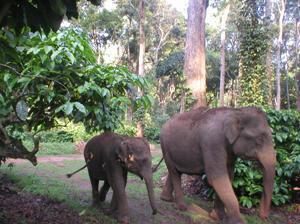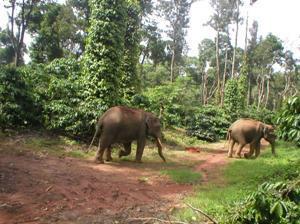Malavika Hosahally Narayana
The project aims to explore the foraging and crop-raiding behaviour of Asian elephants in Kodagu region and to promote positive local attitudes towards elephants and participation in elephant conservation.

The mother and her calf.
Asian elephant (Elephas maximus) populations are severely threatened by habitat loss and conflict with humans. Kodagu (total area 4,102 km²), Southern India, lies on the eastern slopes of the Western Ghats which is one of the top global Biodiversity hotspots (e.g., Myers et al. 2000; Nath and Sukumar, 1998) is a home to 12% of India’s total elephant populations. The major problem in the area is human-elephant conflict (HEC). Recent land transformations across the region’s agroforestry landscape have led to further habitat loss and increased HEC. Besides few studies on regional patterns of the conflict and coping strategies developed by various institutions (Nath and Sukumar, 1998; Kulkarni et al. 2007; Bal et al. 1998), there is no other ongoing research to understand and monitor the problem.

Elephants in one of the coffee estates.
My previous study (Narayana, 2009, unpublished data) also indicated a lack of detailed ecological analysis of HEC in the region, e.g., seasonal or habitat-mediated changes in HEC and also local participation in HEC management was minimal, despite this being crucial for successful conservation (Kulkarni et al. 2007; Bal et al. 2008). Conservation activities in the region are constrained by limited data available on elephant population structure, dynamics, and habitat use and movement patterns. Landscape-level management strategies are necessary to minimise contacts and conflict in human-dominated settings.
This proposed detailed follow-on study will examine the behavioural dynamics of elephants to better understand crop-raiding and conflict with humans. The project will estimate density of elephant population, age-sex structure and will examine agroforestry land-use pattern of elephants in the region and identify the “problem” individuals. In the second phase, the project aims to promote positive local attitudes towards elephants and participation in elephant conservation programs. Information gained will contribute to landscape-scale management conservation strategies for the region and identify implications conservation of Asian elephant conservation.